A Guide to Viewing Dark Skies in Kansas
| Updated on January 10, 2019
Whether it’s the Perseids in August or the Geminids in December, Kansas is a great place to watch a meteor shower! It’s also a great place to photograph meteors! This guide should help you find some amazing spots in Kansas.
Light Pollution
First off, like any good meteor shower guide, dark skies are the key to maximizing how many meteors you will see! That’s not to say you can’t view a meteor shower from a city. Even within cities such as Wichita, Topeka and Kansas City, it’s still possible to see a few meteors this time of year. But the further away from major towns you can get, the skies will become darker, the more stars you will see, and inevitably, more meteors!
Second, not only do you need to keep in mind that light pollution from cities and towns will drown out all but the brightest of meteors, but the moon is a major source of light as well. Even a half moon is bright enough to drown out a large percentage of meteors. Finding a time when the moon is not in view is critical to good meteor viewing. Websites like Time and Date can be really helpful to find out if there will be a new moon or when the moon rises and sets.
Weather
Obviously clear skies are the best condition with which to view meteor showers. But even if the sky isn’t perfectly clear, you can still see a few meteors in partly cloudy skies. Be persistant and watch the weather to see what it will be doing on any given night. Also keep in mind that even though a meteor shower may peak on a certain date, many showers will start well before that date, and linger on for a while.
With all that out of the way, I’m going to give you some pointers on some of my favorite Kansas locations to check out!
Kansas Dark Sky Locations
My favorite place to view dark skies and meteor showers in Kansas is the Flint Hills! The Flint Hills are full of so many awesome spots to view a meteor shower it isn’t even funny! I could fill a book on the countless backroads, landmarks, lakes and other places that would make the Flint Hills the perfect place to view a meteor shower. Let’s run through a few spots though!
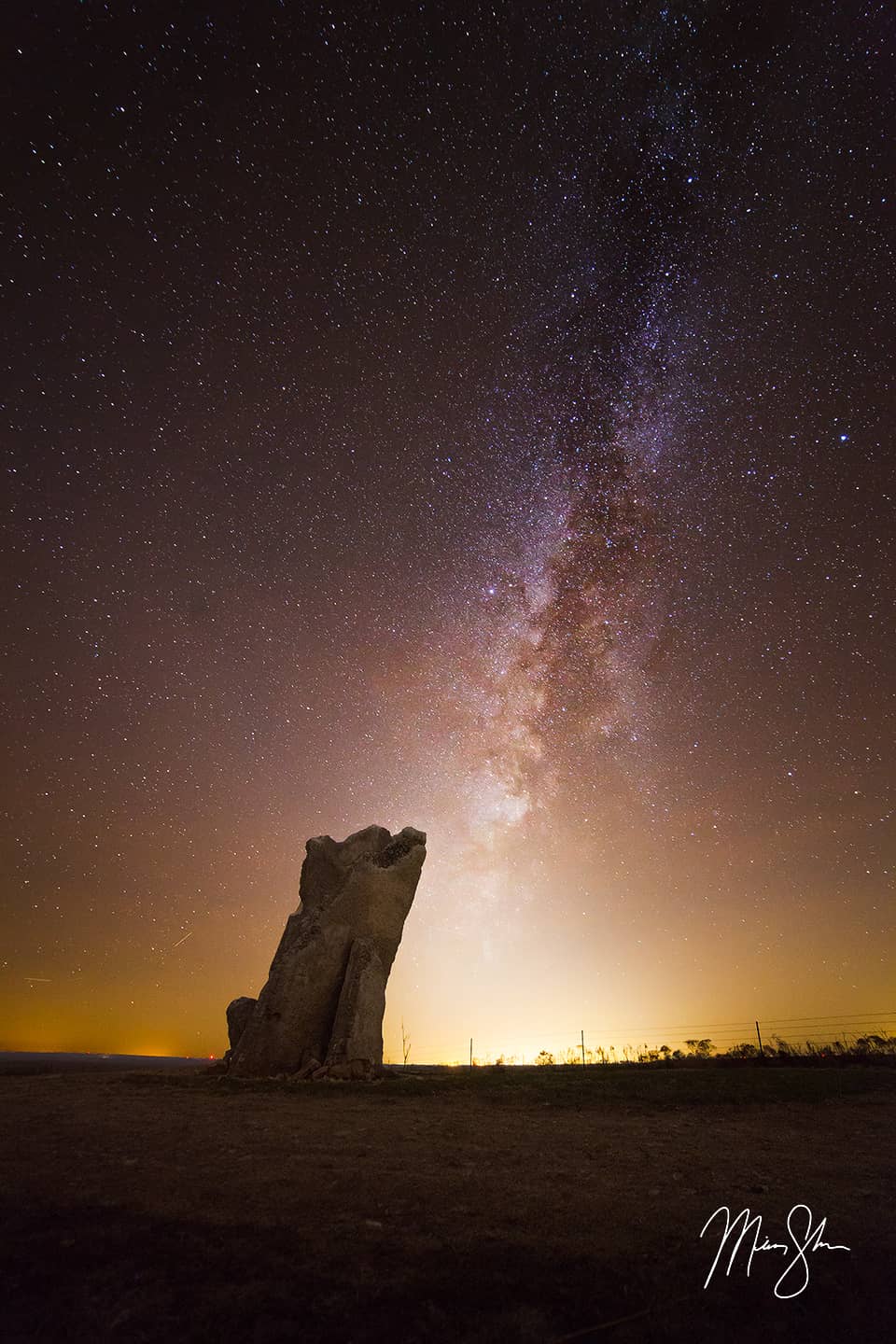
The Milky Way stands tall at Teter Rock
Teter Rock. This little gem in the Flint Hills east of Cassoday has been my go-to place for years as a night photographer! The skies are fairly dark in most directions from here. There’s a hint of light pollution to the northeast where Emporia is and to the southwest where El Dorado is and you can see the flashing lights of the wind farm to the south, but overall, you’re far enough from all of these that it shouldn’t be a problem. To get there, visit Teter Rock’s page on Kansas is Beautiful for a map and directions to the right location.
Sometimes during major meteor showers, Teter Rock can actually get kind of packed with astrophotographers and other folks just trying to find a dark spot for meteor viewing. So if you run into a small parking lot of cars here, don’t worry, there’s a plethora of backroads in the area where you can park just about anywhere to view the meteor shower. One such road is the open range road out to Texaco Hill, another great spot with views in all directions. This road is just a little further to east from the Teter Rock turn, and heads north for a few miles across gorgeous Flint Hills open-ranch road. View the Texaco Hill and Flint Hills Wildlife Drive for more spots along the backroads in this area of the Flint Hills. Just about anywhere along the Flint Hills Wildlife Drive will produce beautiful dark skies and great scenery for meteor shower viewing! Just remember you are on open range road, so cattle might be on the road.
If you were hoping for a spot closer to a major highway in the Flint Hills, the Tallgrass Prairie National Preserve is technically open 24 hours to hiking. Any trail along there would yield great views in all directions, with only the small towns of Strong City and Cottonwood Falls to the south as light pollution competition. If getting out and hiking in the dark isn’t your thing, Lower Fox Creek Schoolhouse is just off the highway in the Tallgrass Prairie National Preserve and provides a wonderful place to watch the meteors.
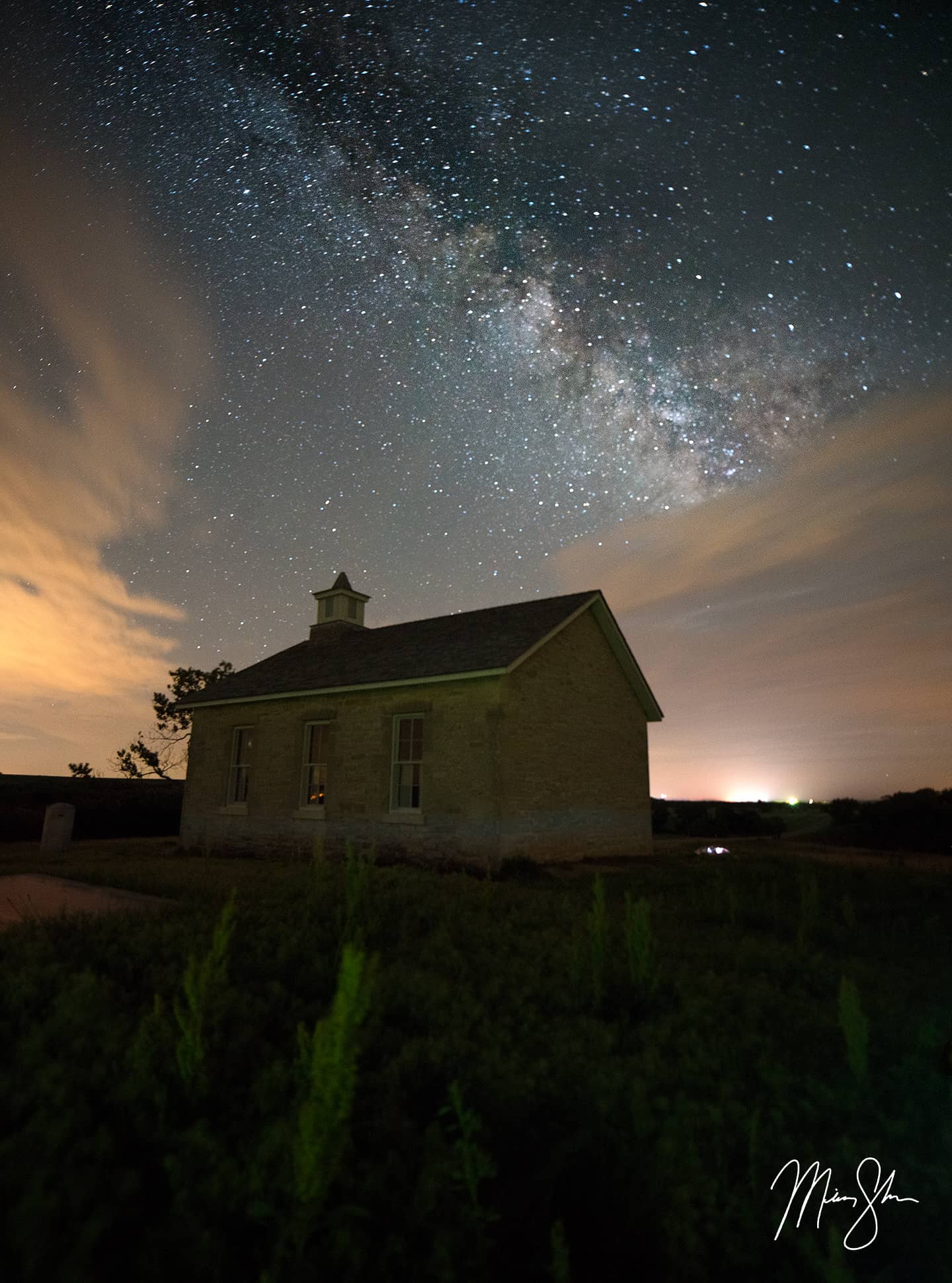
The Milky Way rises above the Tallgrass Prairie National Preserve
Further to the northeast, as you get closer to some of the major cities of Kansas is another backroad that has great open sky views. Just west of Topeka, near Alma, is a gravel road called the Skyline Drive. It’s aptly named, because it follows along a ridge on the edge of the Flint Hills. Just about anywhere along this drive has views that span for dozens of miles. It makes for a wonderful spot to stop and watch a meteor shower. I shot the photo below during the Eta Aquarid’s meteor shower in May.
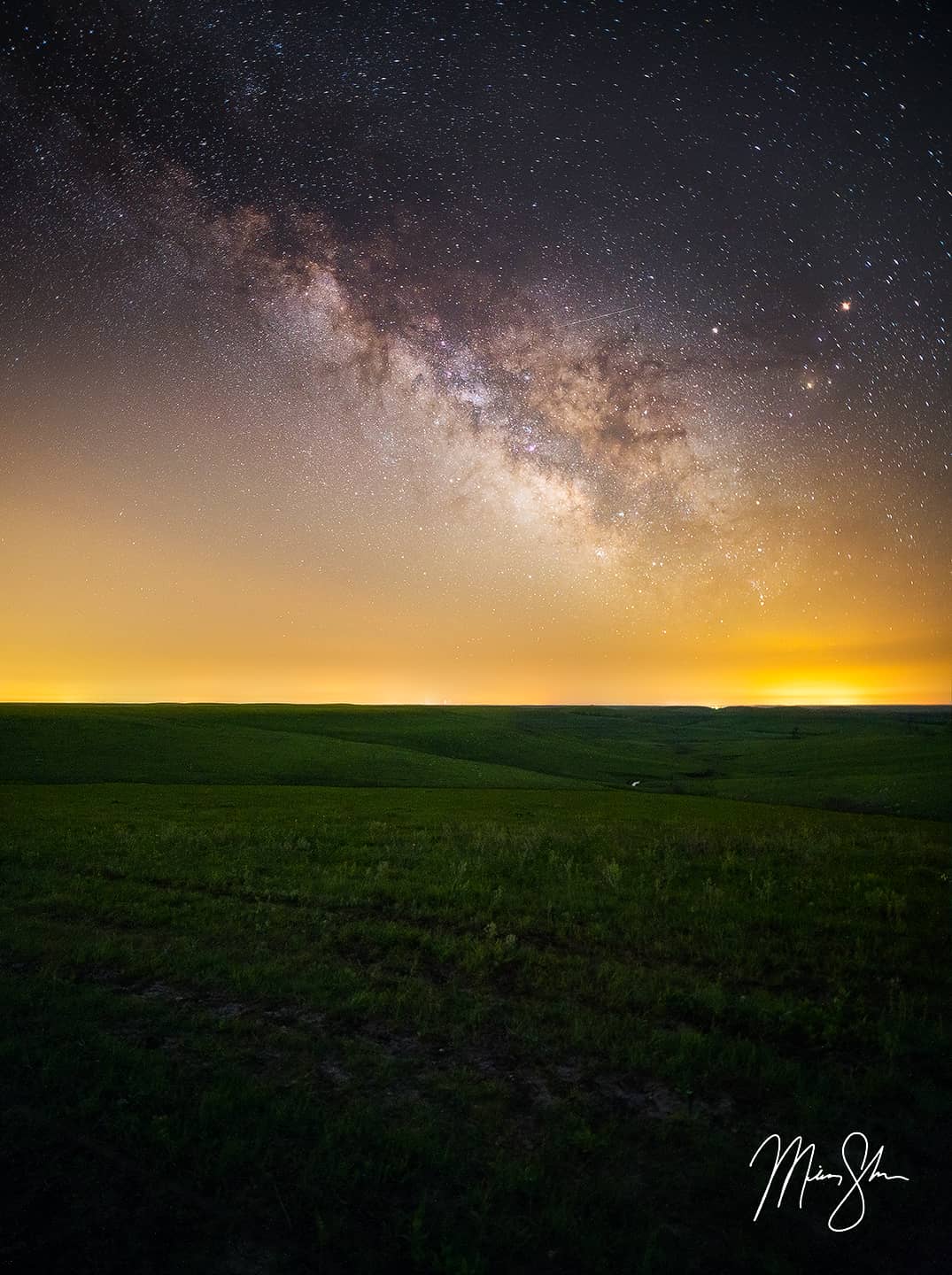
An Eta Aquarid’s meteor streaks in front of the Milky Way along Skyline Drive
Another great spot in Flint Hills are the hills above the eastern side of Tuttle Creek Lake. Chase State Fishing Lake near Cottownwood Falls could make another great spot for meteor viewing.
In northeast Kansas, the northern stretches of the Glacial Hills Scenic Byway are far enough away from Kansas City and the surrounding towns to produce some darker skies. The further west from there that you go into the rural backroads will only get darker and darker as well. Heading to the southeast part of Kansas, many of the state parks could make great dark sky spots for viewing. Somewhere along the dam at Elk City State Park or above Bourbon Falls at Bourbon County State Fishing Lake could make great spots for meteor viewing!
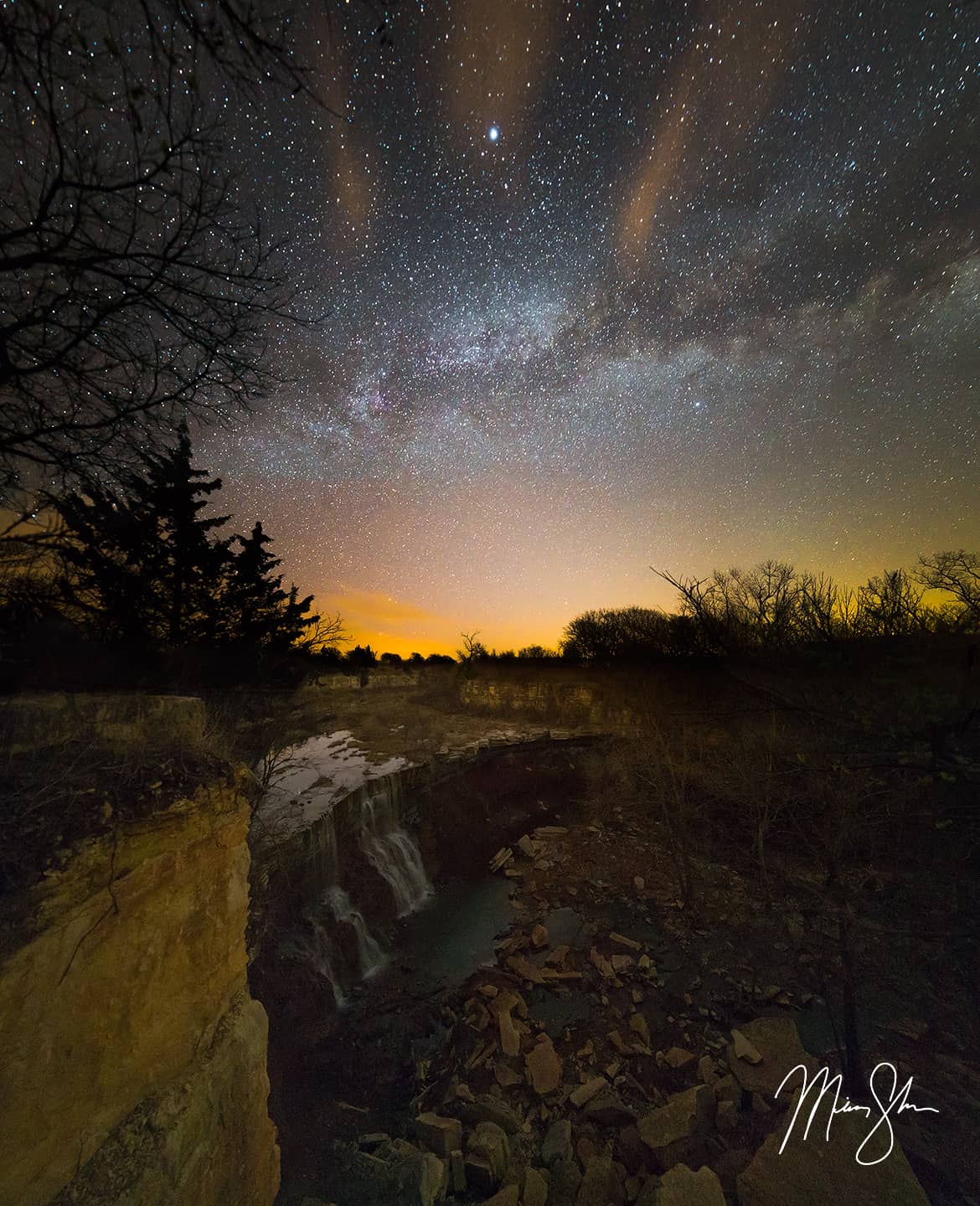
The Milky Way shines bright above the waterfall at Cowley State Fishing Lake
Moving over in south central Kansas, Cowley State Fishing Lake is always a dark sky area. I shot the image above back in February. The lake is down in a valley though, so finding a spot on a hill overlooking the lake would be better than at the shoreline of the lake. Any area down here (as long as you’re a few miles from Ark City and Winfield) should make for dark skies, as Wichita is many miles away.
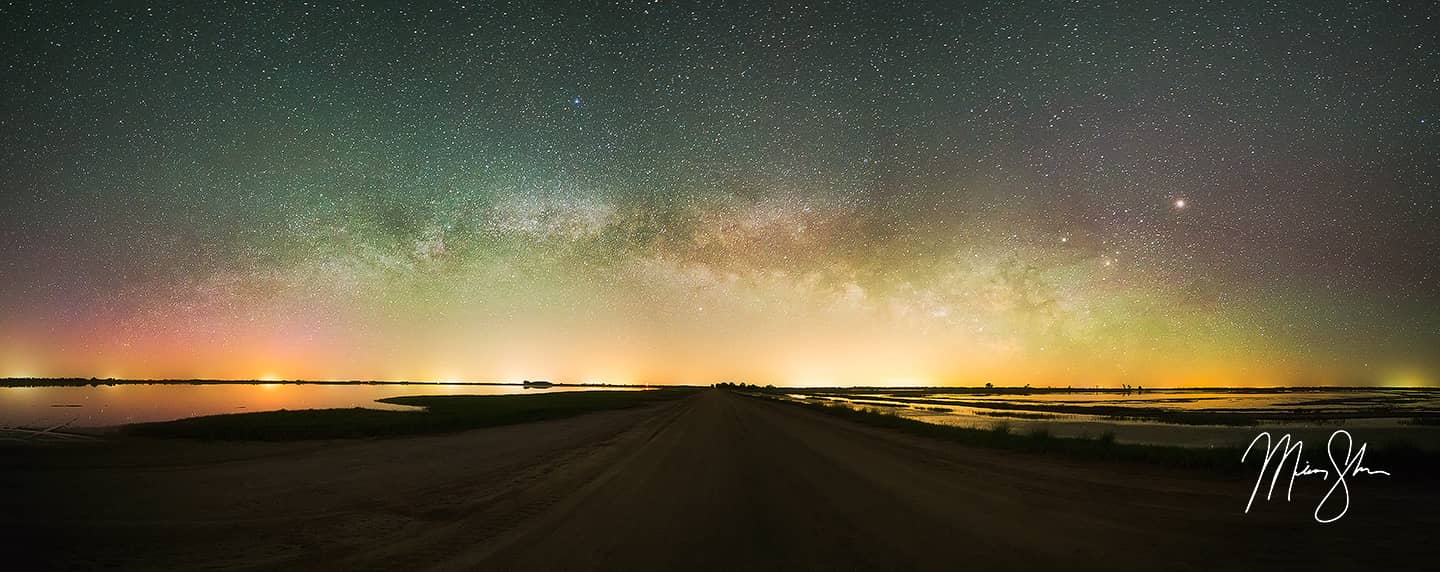
A Milky Way Panorama with a hint of the Aurora at Quivira National Wildlife Refuge
Further north, into central Kansas lies Quivira National Wildlife Refuge, the Wetlands and Wildlife National Scenic Byway and Cheyenne Bottoms. Full of many ponds, lakes and wildlife, this can be a great place to view the stars as well. Just make sure to bring bug spray if you’re out early in the evening! The mosquitos are thick in these parts! But on a windless night the plethora of stars with meteors and the Milky Way reflecting in the wetlands makes for a wonderful night of star-gazing!
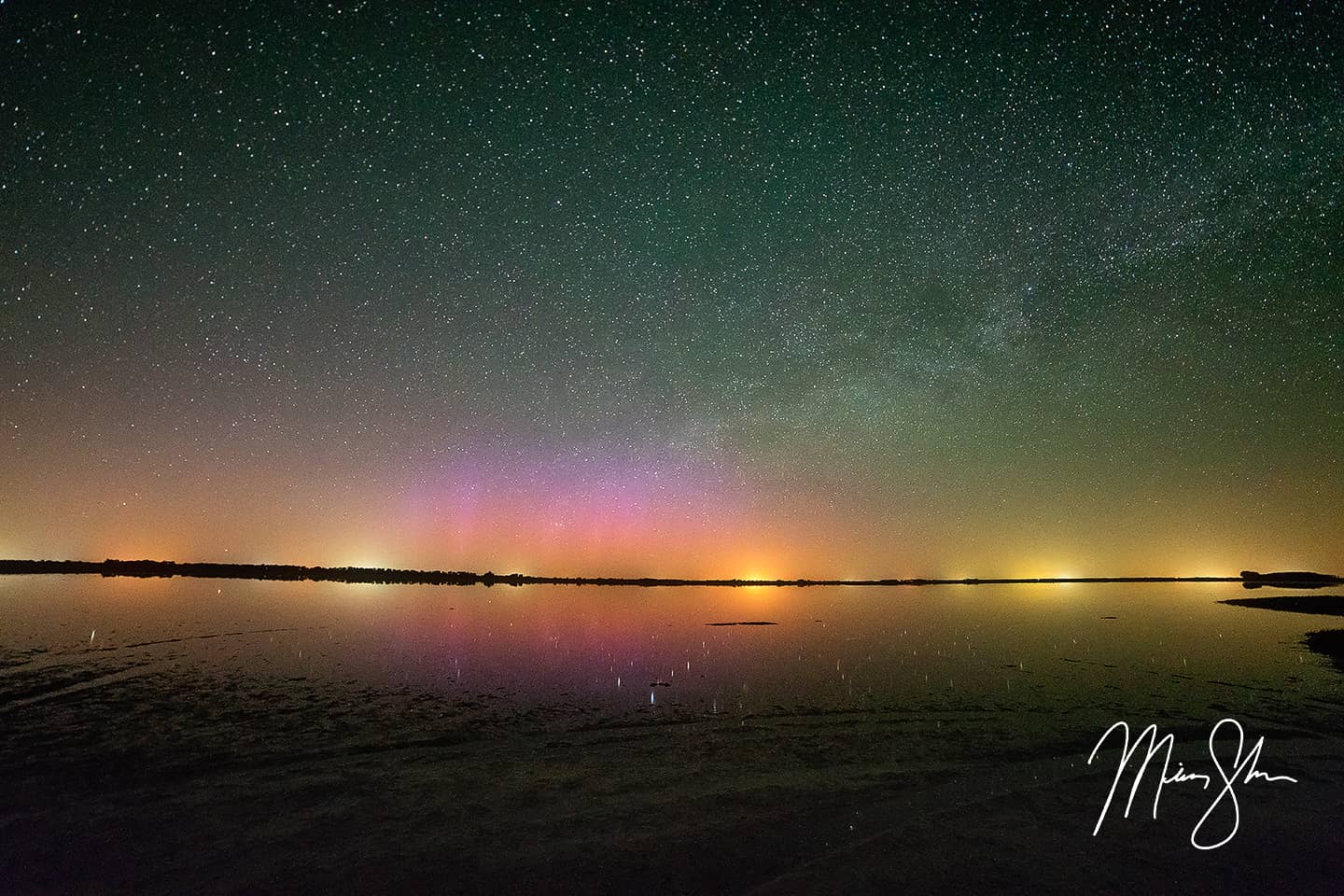
On a rare occasion the Northern Lights even come to visit us in Kansas
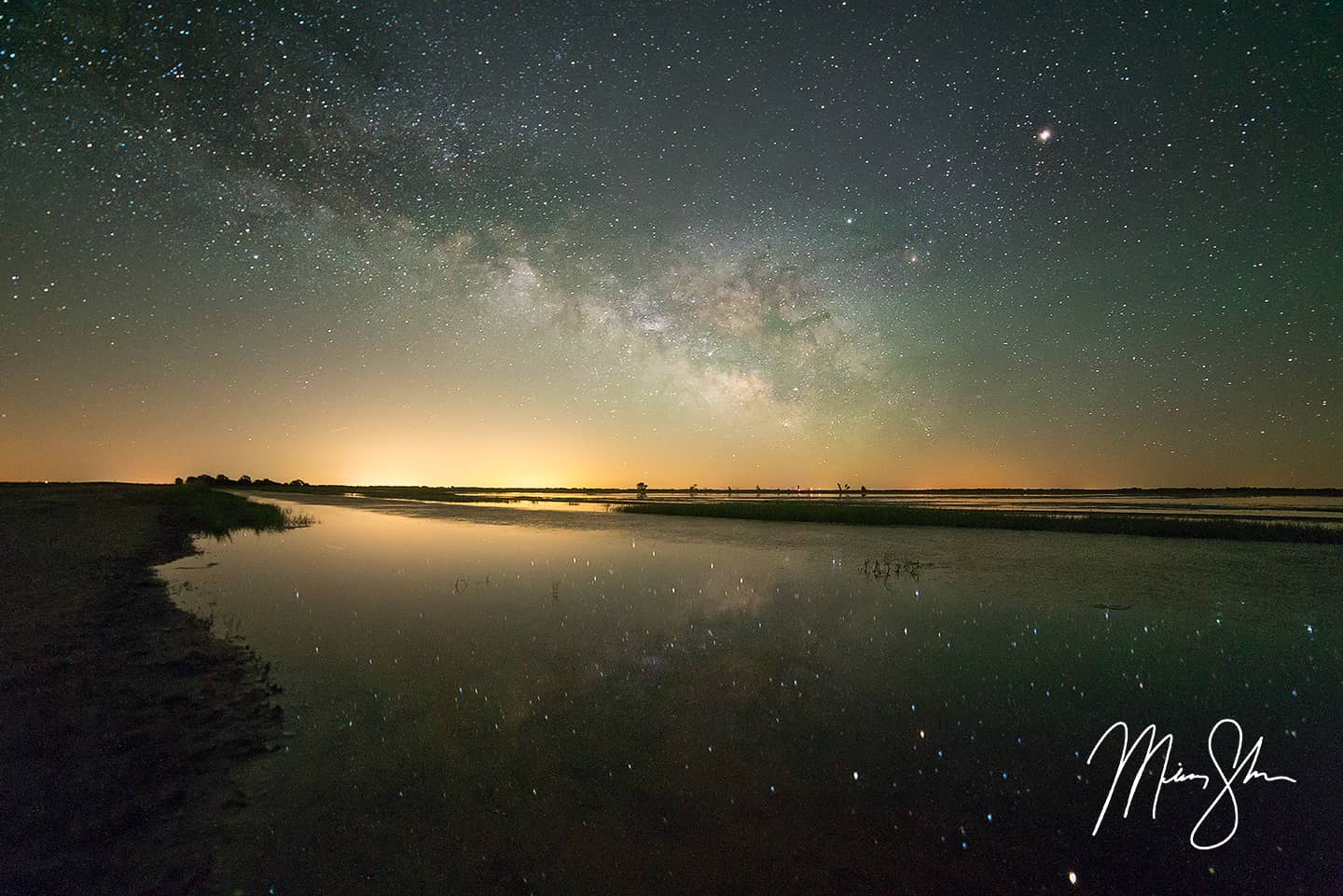
The Milky Way reflects into a pond at Quivira National Wildlife Refuge
Moving a little further north, the Prairie Trail Scenic Byway has a plethora of fun places to watch a meteor shower from, so long as you stay away from the bigger towns of McPherson and Salina. Near Lindsborg, Coronado Heights is a nice spot high above the surrounding Smoky Valley hills. If you’re from central Kansas, it’s a great place to star-gaze and you’re for sure to see some meteors. Moving further west along the Prairie Trail Scenic Byway will only get better as you move away from the lights of I-135 and it’s cities. Scenes like the ones below will become the norm out in the rural areas along this fantastic stretch of Kansas byway.
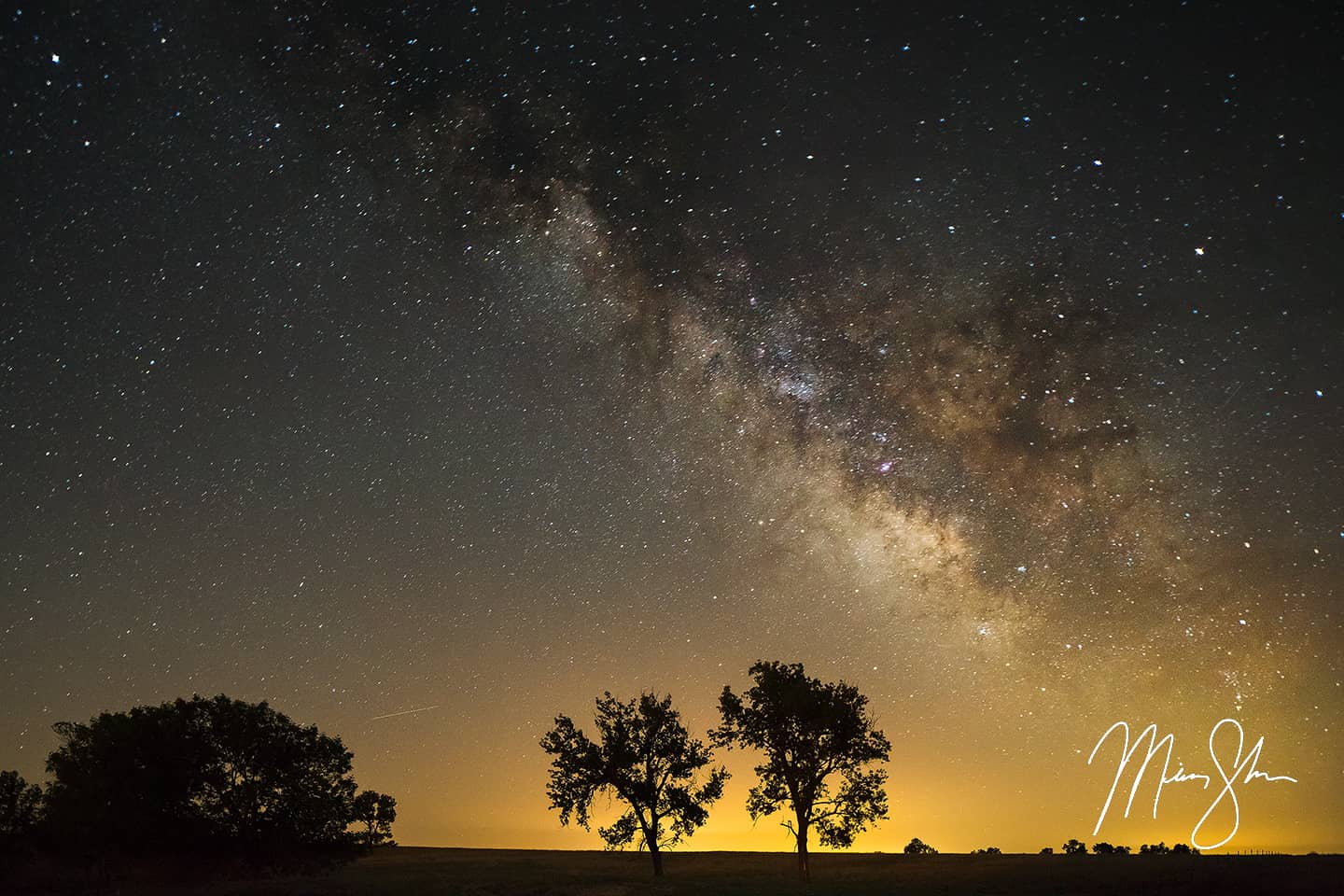
This photo is the winner of the June KLM Monthly Photo Contest
Along this byway, a few of the great state parks of Kansas can make for some great dark sky viewing as well. Kanopolis State Park provides a great place to throw down a tent and sit out under the stars to admire the meteor shower. Just down the road, along a small gravel road stretch of the Prairie Trail Scenic Byway lies Mushroom Rock State Park, another great spot to watch meteors fly by.
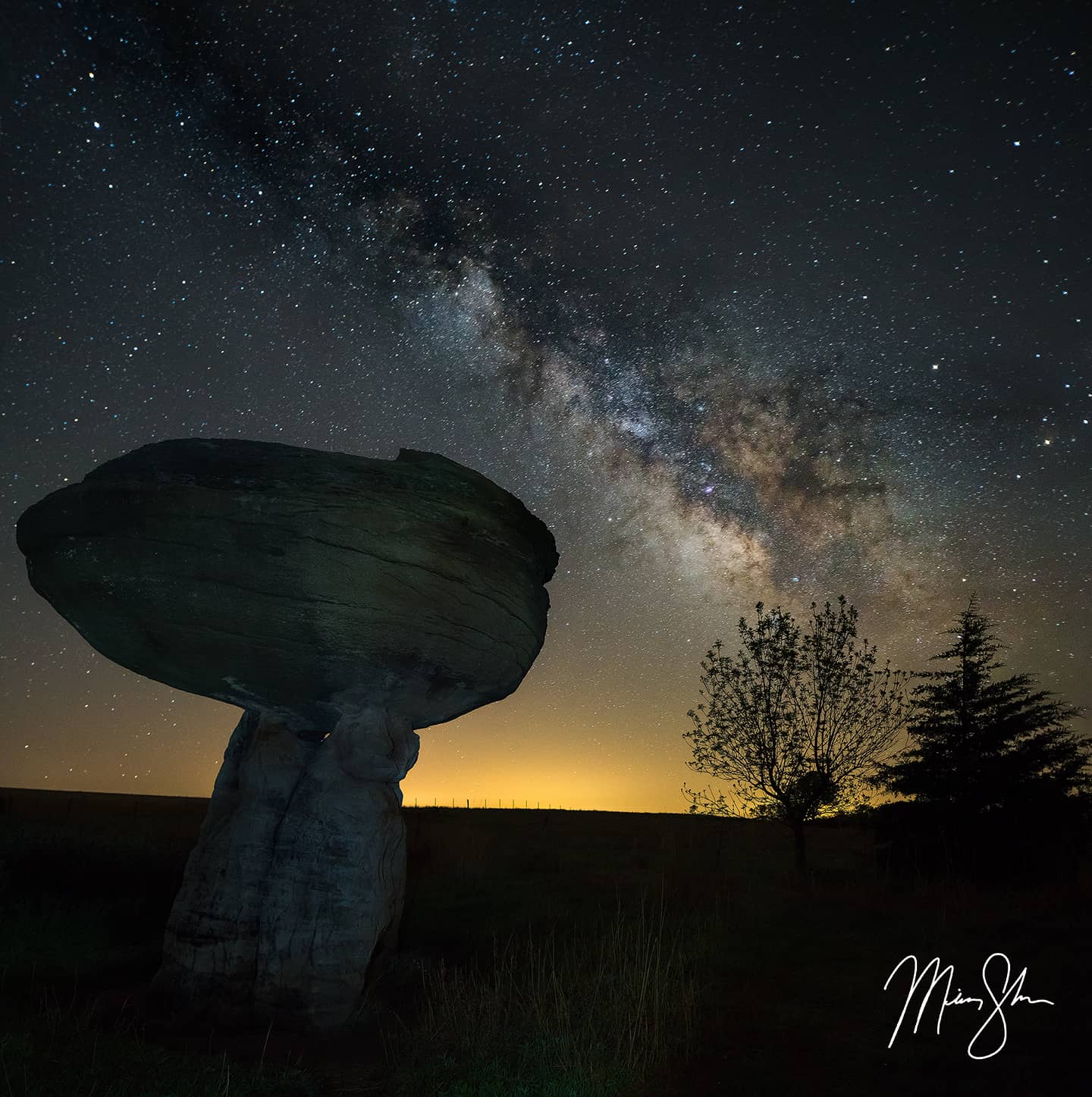
The Milky Way spans out above Mushroom Rock State Park
Moving southwest from here, anywhere in the Gypsum Hills would make a solid spot for dark skies to watch the meteor shower. Anywhere along the Gypsum Hills Scenic Byway or the many backroads nearby make for wonderful viewing spots far away from any major city. Medicine Lodge is the only larger town in the area, and it sits on the east edge of the Gypsum Hills. Get a dozen miles or more to the west, and the skies will be full of stars! If you want to go even farther, head to the western edge of the Gypsum Hills to visit Big Basin for some great scenery and a major lack of light pollution!
And finally, western Kansas is possibly the best bet for great dark sky scenery! As long as some of the bigger towns, such as Dodge City, Garden City, Goodland, etc. aren’t within a few miles of you, you can pretty much park on the side of any backroad and enjoy! Some of my favorite spots include Monument Rocks (please note: I’ve been informed recently that permission is required to be there after dark), Castle Rock, Wilson Lake State Park or Lake Scott State Park. All of these places make for great dark skies viewing!
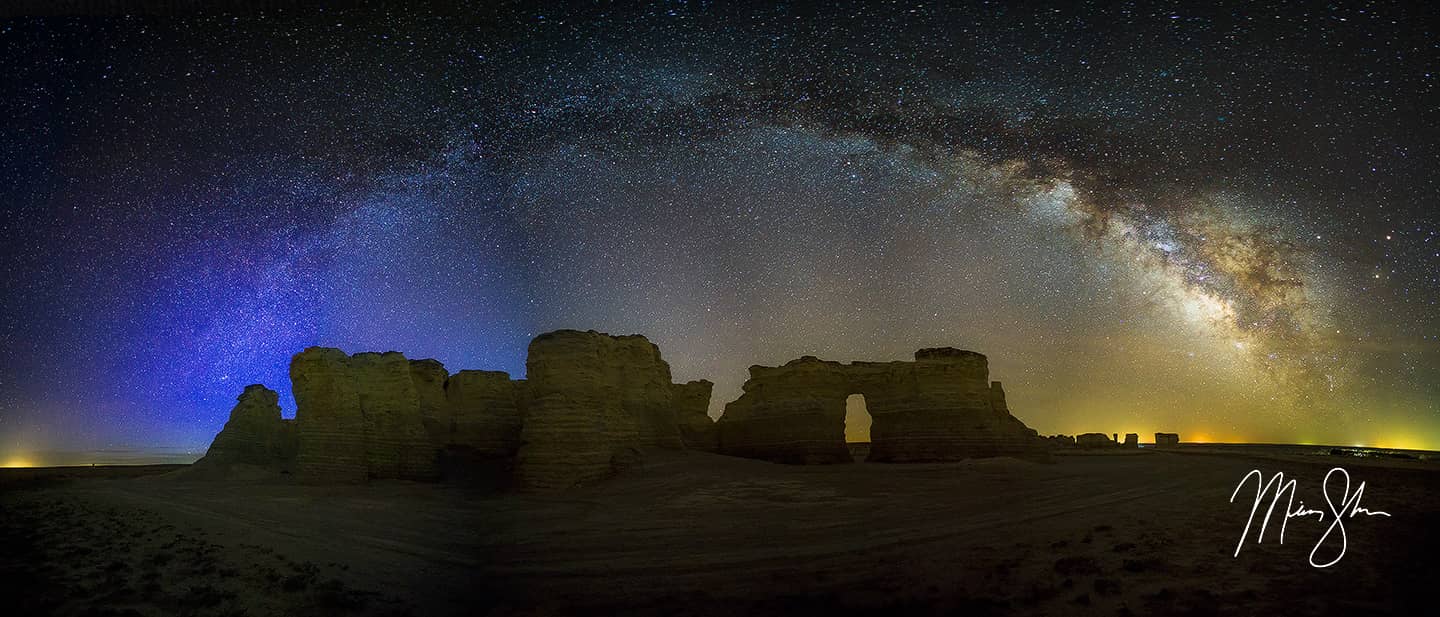
A huge panorama of the Milky Way at Monument Rocks
If you’re feeling really adventurous, a drive out into the Arikaree Breaks of extreme northwest Kansas would make for some serious star-gazing far removed from any major city! Extreme southwest Kansas also makes for wonderful meteor shower viewing. The Cimarron National Grassland is a wonderful place for watching meteors streak by. The best thing about the grasslands is the lack of towns to the north, where meteors should originate from.
Hopefully you’ve enjoyed reading about some of the best places to watch meteor showers in Kansas. While the above locations may be some of my favorites for viewing and photographing the night sky here in Kansas, you can undoubtedly find dark skies in most locations around the state. Just get away from the big cities, wait for the moon to set, sit back and enjoy!
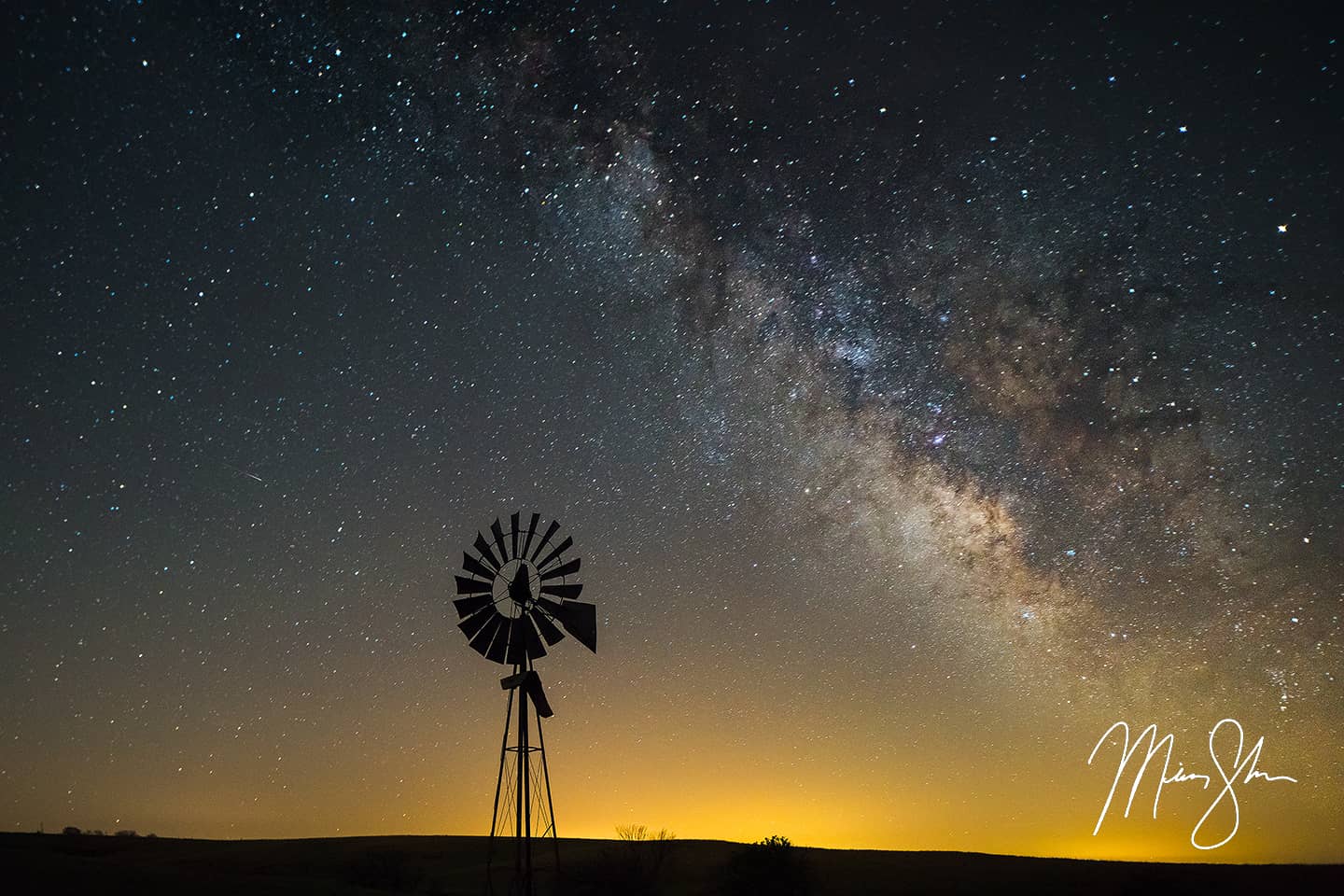
A windmill is silhouetted by the beautiful Milky Way
Tips on Photographing Meteors
For those aspiring photographers that would like to try their hand at photographing a meteor, I’ve got a few tips for you. First off, make sure you have a sturdy tripod! That’s the key! With the length of time your shutter will be open, there’s no getting around having some way to keep the camera steady during the shot. Another piece of equipment that’s helpful to have is a remote shutter of some kind. There are both wired and wireless versions out there. Wireless would obviously be best, as any amount of movement can cause even the tiniest of camera shakes.
Once you have your camera mounted up to your tripod, point the camera towards the constellation Perseus. Having a wide angle lens (14mm is great, 18mm, even 24mm will do) to capture as much of the sky as possible will help get the most meteors. Light is precious at this hour of the night, so setting your aperture (f-stop) to be wide open will let in the most light. When it comes to the ISO and shutter speed, you’ll need to practice a little to see what works best.
Meteors are only in the sky for short periods of time. Most streak by in a blink of the eye. So the shutter speed can be a bit of a double edged sword. You need a longer shutter speed to capture more light from the stars and foreground, but you don’t want it too long as the light from the meteor will fade. If you exposure for 30 seconds, and that meteor is only in the sky for 1/4 of a second, it would have to be a really bright meteor for it not to be partially darkened out by the other 29 and 3/4ths of a second of darkness that the rest of the shot will register.
With ISO, some cameras do better at higher ISOs than others. A good rule of thumb would be to start at around 6400 ISO and work down. If you can get by at 2000, the less grainy the shot will be. But the higher the ISO, the shorter your shutter speed can be. Just practice with these two settings and find a good balance.
Also, being able to set your camera up on a continuos burst of shooting can save you some work. If you can set the camera to continuously shoot, eventually you’re almost guaranteed to catch a meteor or two! But with all things photography, practice makes perfect. And just being out there trying to get a photo of a meteor can be quite the fun ordeal!
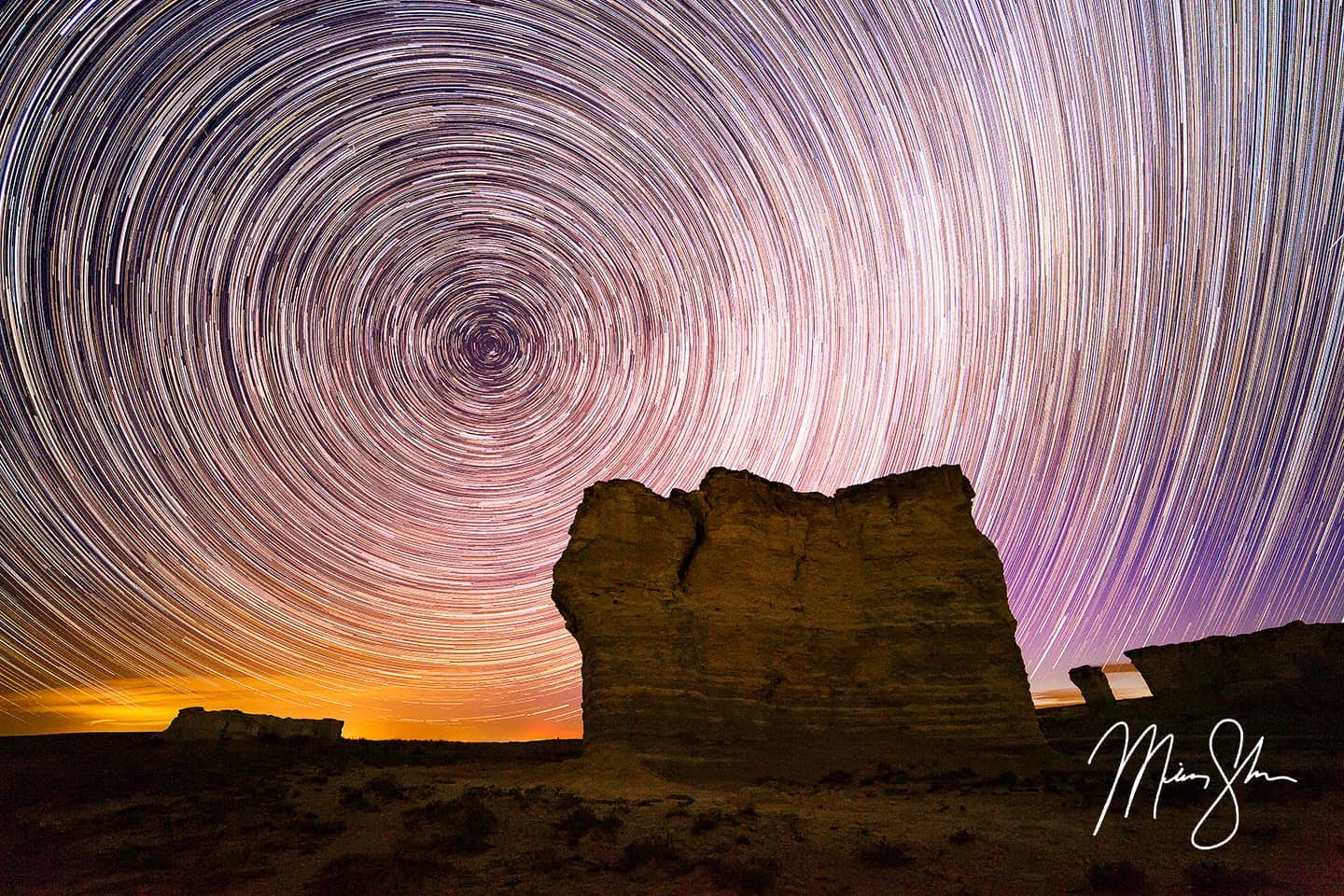
Star trails at Monument Rocks in western Kansas
One more note about shutter speed worth considering is the movement of stars in the sky. Depending on the focal length, you will start seeing something called star trails if your shutter speed is over 20-30 seconds. Star trails look like the stars are moving in the sky. In reality though, the earth is spinning and moving through space, making the stars streak through the sky. Star trails can make for great shots, but when shooting meteors or the Milky Way, it’s not exactly welcoming. If possible, it’s best to keep your shutter speed at 45 seconds or below to minimize the trails.